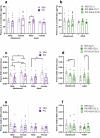Association between redox dysregulation and vulnerability to cognitive deficits induced by maternal immune activation
- PMID: 40419496
- PMCID: PMC12106723
- DOI: 10.1038/s41398-025-03398-0
Association between redox dysregulation and vulnerability to cognitive deficits induced by maternal immune activation
Abstract
Exposure to maternal immune activation (MIA) in utero is a major risk factor for neurodevelopmental disorders, including schizophrenia. However, a proportion of individuals are resilient to developing schizophrenia following exposure to MIA, which has also been reported in animal models of MIA. The molecular mechanisms leading to resilient and vulnerable behavioural phenotypes remain poorly understood, and we currently lack reliable blood biomarkers that predict resilience or vulnerability. Redox dysregulation, caused by an imbalance between oxidative stress and antioxidant defence mechanisms, has recently been predicted to be central to the pathogenesis of schizophrenia. Here, we use a poly(I:C)-induced MIA model of schizophrenia to investigate mechanisms underlying cognitive dysfunction and redox dysregulation in resilient and vulnerable individuals. We show that activity of the antioxidant enzyme superoxide dismutase (SOD) was reduced in the plasma of poly(I:C) offspring with a cognitive deficit, in contrast to individuals with typical cognition during both adolescence and adulthood. However, SOD activity in the hippocampus was not significantly different between vulnerable and resilient offspring. In addition, the lipid peroxidation marker malondialdehyde (MDA) and the pro-inflammatory cytokine IL-6 were not differentially expressed within the hippocampus or plasma of vulnerable poly(I:C) offspring. Our results suggest that reduced plasma SOD activity may be a potential blood biomarker to identify resilience or vulnerability to MIA-induced cognitive deficits. Further research is necessary to determine if reduced antioxidant capacity is present in plasma prior to symptom presentation and to understand if this predicts redox dysregulation in the brain.
© 2025. The Author(s).
Conflict of interest statement
Competing interests: The authors declare no competing interests.
Figures



Similar articles
-
Maternal Immune Activation Causes Schizophrenia-like Behaviors in the Offspring through Activation of Immune-Inflammatory, Oxidative and Apoptotic Pathways, and Lowered Antioxidant Defenses and Neuroprotection.Mol Neurobiol. 2020 Oct;57(10):4345-4361. doi: 10.1007/s12035-020-02028-8. Epub 2020 Jul 27. Mol Neurobiol. 2020. PMID: 32720073
-
The risk for behavioural deficits is determined by the maternal immune response to prenatal immune challenge in a neurodevelopmental model.Brain Behav Immun. 2014 Nov;42:138-46. doi: 10.1016/j.bbi.2014.06.013. Epub 2014 Jun 26. Brain Behav Immun. 2014. PMID: 24973728
-
Cannabidiol improves behavioural and neurochemical deficits in adult female offspring of the maternal immune activation (poly I:C) model of neurodevelopmental disorders.Brain Behav Immun. 2019 Oct;81:574-587. doi: 10.1016/j.bbi.2019.07.018. Epub 2019 Jul 19. Brain Behav Immun. 2019. PMID: 31326506
-
The Outcomes of Maternal Immune Activation Induced with the Viral Mimetic Poly I:C on Microglia in Exposed Rodent Offspring.Dev Neurosci. 2023;45(4):191-209. doi: 10.1159/000530185. Epub 2023 Mar 21. Dev Neurosci. 2023. PMID: 36944325 Review.
-
Maternal Immune Activation by Poly I:C as a preclinical Model for Neurodevelopmental Disorders: A focus on Autism and Schizophrenia.Neurosci Biobehav Rev. 2020 Jun;113:546-567. doi: 10.1016/j.neubiorev.2020.04.012. Epub 2020 Apr 19. Neurosci Biobehav Rev. 2020. PMID: 32320814 Review.
References
-
- Bhandari R, Paliwal JK, Kuhad A. Neuropsychopathology of autism spectrum disorder: complex interplay of genetic, epigenetic, and environmental factors. Adv Neurobiol. 2020;24:97–141. - PubMed
-
- Santos S, Ferreira H, Martins J, Goncalves J, Castelo-Branco M. Male sex bias in early and late onset neurodevelopmental disorders: Shared aspects and differences in autism spectrum disorder, attention deficit/hyperactivity disorder, and schizophrenia. Neurosci Biobehav Rev. 2022;135:104577. - PubMed
-
- Mednick SA, Machon RA, Huttunen MO, Bonett D. Adult schizophrenia following prenatal exposure to an influenza epidemic. Arch Gen Psychiatry. 1988;45:189–92. - PubMed
MeSH terms
Substances
Grants and funding
LinkOut - more resources
Full Text Sources
Medical

